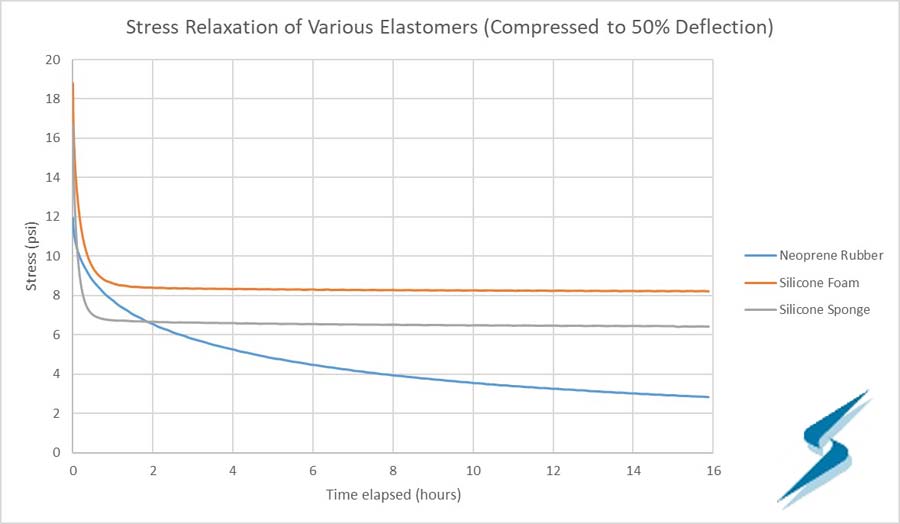Contact Stockwell Elastomerics
Request a quote or get more information.
Compression set and stress relaxation are two terms that come up in conversations with customers regarding different applications of materials offered by Stockwell Elastomerics. These terms refer to compression phenomena that occur in elastomeric materials. While there are correlations between the two, it is important to understand each phenomenon and how it relates to material performance.
Compression set is a measurement of a material’s tendency to retain compression deflection after force is removed. This measurement is in terms of displacement, or strain – a silicone foam like BISCO® HT-800 has a listed compression set % of 2.4. In simple terms, this means that HT-800 tends to recover 97.6% of whatever distance it is compressed. It is easy to confuse compression set for a measurement of stress retained – this is incorrect. Compression set only refers to the amount of displacement, also known as strain, retained once compression force is removed. The amount of stress retained in a material while compressed is an entirely different phenomenon known as stress relaxation.
It is important not to rely only on the datasheet values for compression set when evaluating materials. The compression set value listed on elastomer datasheets reflects results from an ASTM standard that dictates fairly extreme conditions. The compression set data found on material datasheets is most useful for comparison between materials – the datasheet values are great to identify materials that are better at resisting compression set than others, but in actual applications, conditions such as temperature, compression deflection, fluid contact, and shape factors all contribute to compression set.
Stress relaxation is often mixed up with compression set. Compression set measures strain that is retained once compression force is removed, but stress relaxation measures retained stress over time when strain is held constant. To simplify this, let’s examine how this can be measured: 3 different materials are compressed down to 50% of their nominal thickness using a machine that can measure the “pushback” force. The materials are held in this state over many hours, and the pushback force is measured constantly. All elastomeric materials will lose pushback force over time – this is what is called stress relaxation. A graph of this exact scenario is provided below.
Silicone is a superior sealing solution in many applications; some commonly known benefits are its high and low-temperature resistance, chemical resistance, and long term performance. This is not the only benefit of silicone – with regards to compression set resistance and stress relaxation, silicone elastomers also outperform the other materials.
For compression set, most silicone foam and silicone sponge datasheets list compression set values per the ASTM standard mentioned previously. Take a look at some of the silicone sponge and silicons foam datasheets – compression set values can be as low as 2%. Again, these values are tested at extreme conditions – most applications will see even less compression set in actual use. Non-silicone elastomers such as EPDM and neoprene experience a much more drastic set – even taking a small swatch in your hand and compressing with a binder clip can demonstrate these materials’ inability to “bounce back” to their original thickness.
Additionally, silicone’s high temperature resistance gives it significantly better compression set resistance at elevated temperatures. Some non-silicone elastomers can exhibit acceptable compression set at room temperature, but typically these products have extremely poor compression set resistance once temperatures are elevated to 140°F and above. In this sense, silicone stands almost alone: most elastomers will fail to survive, let alone have desirable mechanical properties, at high temperatures. At these same high temperatures, silicone still exhibits the superior mechanical properties that make it such an effective material choice.
For stress relaxation, take a close look at the graph below.

It is clear that all 3 materials lose pushback force over time – for silicone it happens a bit more rapidly than neoprene rubber. However, after just a few hours, silicone materials reach a “steady state” pushback force while the non-silicone material continues to relax. This helps to understand why silicone is such a great long term sealing material – under fixed strain (i.e assembled between two mating housings in a finished product as a dust seal) silicone continues to “push back”. This is a key mechanism in sealing – at the seal interface, if a gasket fails to produce proper pushback, foreign unwanted fluids and objects can intrude.
In summary, understanding compression set and stress relaxation can help designers and eningeers choose appropriate materials for specific applications, and also provides insight into why a material like silicone is a superior long term sealing choice.
Contact a Stockwell Elastomerics Application Engineer for help with material selection for silicone gaskets, silicone seals, and silicone pads for various applications.
Request a quote or get more information.
